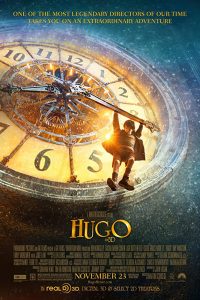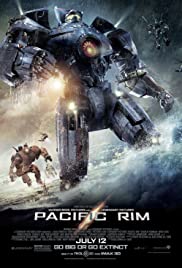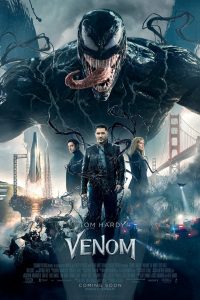Clash of the Titans: Josh Pearce and Arley Sorg Discuss Godzilla vs. Kong
 In our review of Godzilla: King of the Monsters, we said, “The weakness of this movie was the humans and the strengths were the monsters, and there were not enough monster moments.” Well. The movie studios listened. Godzilla vs. Kong centers the monsters more than ever, not only offering several fight scenes of decent length and in varying locales, but even developing a story arc for Kong: this monster isn’t just a pretty face, but a protagonist undertaking a journey, albeit a fairly simplistic one.
In our review of Godzilla: King of the Monsters, we said, “The weakness of this movie was the humans and the strengths were the monsters, and there were not enough monster moments.” Well. The movie studios listened. Godzilla vs. Kong centers the monsters more than ever, not only offering several fight scenes of decent length and in varying locales, but even developing a story arc for Kong: this monster isn’t just a pretty face, but a protagonist undertaking a journey, albeit a fairly simplistic one.
You almost forget that, technically, there’s this other entire plot going on, involving humans. The point of the movie, really, is monster fights. The opening credits even look like a video game, with Godzilla and Kong going through one combatant after another to get to the boss level. All other movie elements are just pretense to serve up the battles, and perhaps to cleanse your palate before the next round of fighting. Characters are forgettable, plot details are unremarkable or laughable, and the story logic very thin.
But we came for the monster fights, right?
Josh: I liked the opening credit sequence, actually. It was styled like Japanese woodcut illustrations, and skipped through all the backstory really fast, similar to Underwater‘s opening. That was probably the highlight, for me.
Arley: Overall, it was a fun movie….
Josh: It’s advertised as Godzilla versus Kong, and it delivered on that. So, if we’re discussing, “Did the movie succeed in what it set out to do?” I would say yes, it provided monster fights, but that’s basically all it had to do.
Arley: I feel like with this one, they were all, “We heard the fans, and we’re going to fix our mistakes.” This movie was mostly monster fight. They gave you monsters fighting in different places, they gave you different moves, they gave you different matches.
The movie opens with Kong waking up, dipping into a waterfall, and tossing a homemade spear, all in bright daylight. It’s blatantly showing off the current state of CGI effects. And for the money spent, it does look good. Unlike the last Godzilla movie, where many scenes were obscured by rain or darkness, this one flaunts its state-of-the-art effects, including close ups of growling mouths and a sequence which looks like a Universal Studios ride. The action is easy to see, and the movie makes a point to highlight creature details (many of which will delight long-time Godzilla fans). If an occasional sequence isn’t quite as slick, or reads as slightly more video game, it’s forgivable.
Arley: I kinda miss dudes in rubber suits.
Josh: I actually enjoy movies that have semi-shitty effects. If they do model work, or puppetry, or even stop motion, or a combination of those things, and then fill in the gaps with CGI, it just looks more impressive because of the amount of work and craftsmanship that went into it.
Arley: Sometimes those model works and puppet effects are really good, like in Alien and Aliens. And because it’s a model or puppet, I personally feel like your brain registers that there’s something physically in that space with that person. I feel like with CGI no matter how good it is your brain just knows that it’s digital, it’s not real.
Josh: Agreed. I’ve said this before, but I’m not really super excited about CGI things punching each other. After a while I get bored with, “Okay you guys are punching each other yet again.” I thought Mechagodzilla looked cool, because it was a robot, so I started rooting for that. I thought the rest of the movie was very silly.
Arley: I definitely think this movie is more for the fans. For the people who’ve watched Godzilla movies over the years, or who are really getting into it; or for the kids. ‘Cause the science fiction stuff just doesn’t make any sense.
Josh: The whole hollow earth subplot was really over the top and completely broke my suspension of disbelief. I can buy into giant atomic lizard and giant gorilla punching each other, for the most part, but once they get into flying cars and go through a portal to the center of the Earth where there’s sunlight for some reason…. And it’s pretty much unnecessary to the plot. I’m sure they gave explanations for all that stuff but I stopped listening whenever there was a human on screen.
The “Most Egregious Moments” awards for broken suspension of disbelief go to Godzilla blasting a hole all the way to the hollow center of the Earth (for Josh) and, right after, King Kong climbing out from the hollow center of the Earth in a minute or so (for Arley).
Arley: In the last one we complained about the stupid human plotline, and in this one they’re like, okay the toxic white dude that everyone hated? (AKA Kyle Chandler as Mark Russell.) We’re gonna completely minimize him, and just have him to react to moments of shock. We’re gonna center Millie Bobby Brown and her ragtag gang (Julian Dennison as Josh Valentine and Bryan Tyree Henry as wacky-conspiracy-guy-who-is-actually-right Bernie Hayes) and they’re gonna go on this Goonies-like quest to figure out and stop the conspiracy.
Josh: I like that they sidelined Mark Russell, because he was the worst part of the last one. Then they brought in Alexander Skarsgård and he was just as terrible. I went back to our review of King of the Monsters, and the main complaint I had about that was that it was too grim, without self-aware campiness. But I think it might have gone a little too far in the other direction on this one. There’s a balance to be had in there, somewhere, and they haven’t quite found it.
Arley: That’s because you haven’t seen the original version of this film! (laughs) King Kong looked terrible in it. And not long after, the Godzilla movies started getting really campy.
More like a superhero movie, the hokey, science fictional elements are reminiscent of comic books wherein, for example, being bombarded by gamma radiation or cosmic rays gives you super powers (definitely don’t try those at home). Combined with the predictable plot of two main characters from separate stories initially clashing, only to eventually team up against the real bad guy, and you’ve got Batman vs. Superman.
Josh: Much in the way that Batman would never stand a chance against Superman, King Kong would never stand a chance against Godzilla.
Arley: We will be here all night if we go down that road! They did have perfunctory stabs at meaning and themes, which were still just excuses to get to the next monster fight. In the beginning they had the theme of captivity as poisonous and it’s represented by Kong throwing the spear, he’s yelling at the fact that he’s being imprisoned, and then they exacerbate this and try to develop sympathy for it by showing that he’s actually intelligent, that he can communicate, and then he’s growling at his chains, and then Godzilla’s coming and he’s thrashing at his chains, and all of this is like that whole “captivity, bad” sort of theme. It’s very Star Trek. All we’re missing is Kirk’s monologue about free will or something.
Josh: I know Godzilla is already literalizing the metaphor — he’s an act of God, or a force of nature, or a nuclear meltdown — but it’s like the American versions are trying to literalize the literalization of the metaphor, to take it one step farther, and it’s failing.
Arley: A lot of times in the original Godzilla movies they’re like, “Because aliens. Now what?”
Josh: I would accept that!
There are a few other notes we can throw into this review — the score (as John Wiswell pointed out to Arley in a separate conversation) was pretty much straight out of Man of Steel; Kong had a story arc, while Godzilla definitely did not, which may have had something to do with the rights deal between Legendary Pictures and Toho expiring in 2020 — but at this point, we’ve probably covered the movie in more depth than it deserves.
Josh: I would have liked to see an old school, pulp science fiction version of this: Arthur Conan Doyle-style The Lost World combined with Jules Verne’s Journey to the Center of the Earth. You know, like the original King Kong.
Arley: Mechagodzilla looked cool. And there are all these things about it that are callbacks to old school Mechagodzilla, which was really fun.
Josh: There’s actually a perfectly good core movie of a three-sided monster fight in this that didn’t need any of the other wacky elements. I don’t think I’d recommend this movie to anybody over the age of 14. My nephew’s about that age, and he would probably love it, so there certainly is an audience.
Arley: I loved it. I mean, okay, loved is a weird word. But I was highly entertained by it. It was better than the last one.
Josh: It’s Godzilla vs. Kong. That’s literally it. That’s the review.
Directed by: Adam Wingard
Written by: Terry Rossio, Michael Dougherty, Zach Shields, Eric Pearson & Max Borenstein
Starring: Alexander Skarsgård, Millie Bobby Brown, Rebecca Hall, Brian Tyree Henry, Shun Oguri, Eiza González, Julian Dennison, Lance Reddick & Kyle Chandler

ARLEY SORG, Senior Editor, grew up in England, Hawaii, and Colorado. He lives in Oakland, CA. A 2014 Odyssey Writing Workshop graduate, Arley is co-Editor-in-Chief at Fantasy Magazine, Associate Editor and reviewer at Lightspeed & Nightmare magazines, interviewer at Clarkesworld Magazine, and reviewer for Cascadia Subduction Zone Magazine. He can be found at arleysorg.com – where he has started his own “casual interview” series with authors and editors – and on Twitter (@arleysorg).
JOSH PEARCE, Associate Editor, started working at Locus in 2016. He studied creative writing at SFSU and has sold short stories and poems to a variety of speculative fiction magazines. Born and raised in the Bay Area, he currently lives in the East Bay with his wife and sons and spends way too much time on Twitter: @fictionaljosh. One time, Ken Jennings signed his chest.
 While you are here, please take a moment to support Locus with a one-time or recurring donation. We rely on reader donations to keep the magazine and site going, and would like to keep the site paywall free, but WE NEED YOUR FINANCIAL SUPPORT to continue quality coverage of the science fiction and fantasy field.
While you are here, please take a moment to support Locus with a one-time or recurring donation. We rely on reader donations to keep the magazine and site going, and would like to keep the site paywall free, but WE NEED YOUR FINANCIAL SUPPORT to continue quality coverage of the science fiction and fantasy field.
©Locus Magazine. Copyrighted material may not be republished without permission of LSFF.






